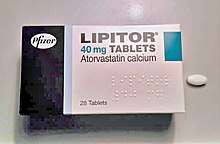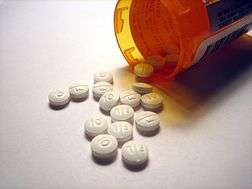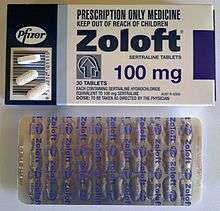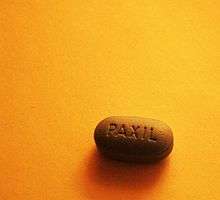Me-too drug
The term "me-too drug" or "follow-on drug" refers to a medication that is similar to a pre-existing drug, usually by making minor modifications to the prototype, reflected in slight changes in the profiles of side effects or activity, and used to treat conditions for which drugs already exist.[1][2] While pharmaceutical companies have justified the development of me-toos as offering improvements in efficacy, side-effects, compliance and cost, critics have questioned the increasing marketing of me-toos, their absorption of research and development resources and their impact on the innovation of new treatments.[3][4][5]
The term is derived from the phrase "me too" and is usually used in a negative way with the implication that the me-too drug is simply exploiting the research and development done to develop the prototype active pharmaceutical ingredient (API). However, me-too drugs can be novel compounds themselves, and drug products containing them can serve to increase market competition and thus to reduce drug prices.[3][6]
History

The term "me‐too drugs" was coined in the 1950s. In 1956, Louis S. Goodman, co‐editor of Goodman and Gilman, referred to “the problem of the introduction of ‘me too’ drugs, that is, drugs without signal advantage of any sort”.[1] Once a new drug class was discovered, other major drug companies made efforts to produce their own similar versions. Pharmacologist Milton Silverman and physician Philip R. Lee noted "the great drug therapy era was marked not only by the introduction of new drugs in great profusion and by the launching of large promotional campaigns but also by the introduction of what are known as 'duplicative' or 'me-too' products".[7]
Between 1960 and 1962, Estes Kefauver, then Senator of Tennessee, led a series of hearings enquiring about the pharmaceutical industry's motive to produce me-too drugs after it was noted that much of their time and resources were spent producing them. Subsequently, the FDA required drug companies to prove their drugs were safe and effective.[7] In 1964, Louis Lasagna described me-too drugs as being “hard to justify putting into man at all, let alone on the market”.[1] Three years later, the term appeared in the Oxford English Dictionary.[1] In the early 1970s, Silverman and Lee reported that there were almost 100 tranquillisers, 130 antihistamines, greater than 270 antibiotics and more than 200 sulfonamides.[7]
In 1994, Desmond Laurence's textbook Clinical Pharmacology referred to me-too as "me-again".[1]
Definition
There is no agreed definition, however, several have been proposed,[1] including:
- "multiple drugs within the same therapeutic class"
- "drugs that are chemically related to the prototype, or other chemical compounds which have an identical mechanism of action"
- "drugs which have more or less identical clinical outcomes to pre‐existing drugs"
- "a drug with a similar chemical structure or the same mechanism of action as a drug that is already marketed".[1]
Biosimilars are compared with other biosimilars and are therefore not me-toos.[8][9]
Examples
Me-too drugs include diazepam, propranolol, ranitidine and esketamine.[1]
Beta blockers
The first-in-class β-blocker pronethalol was developed by James Black at ICI Pharmaceuticals. It was followed by propranolol, sotalol, practolol, metoprolol, labetalol, acebutolol and bisoprolol. Successive differences between β-blockers have had a combined cumulative effect and are seen as "innovative".[1]
Benzodiazepines
15 benzodiazepines were marketed in the UK between 1960 and 1982, of which seven were produced by Roche.[1]
Proton pump inhibitors
The proton-pump inhibitor Nexium by AstraZeneca is a me-too which was granted its patent by showing that it was effective for heartburn, not that it was better than its precursor, prilosec.[10] It was shown to preserve revenues of prilosec, whose U.S. patent expired in 2001. Considered a new drug by the FDA, nexium was patented separately, sold for eight times the cost of its generic esomeprazole and advertised as significantly better than its predecessor, a move the company received much criticism for, with a subsequent class action lawsuit filed against them.[11]
.jpg) Nexium (esomeprazole)
Nexium (esomeprazole)
H2 antagonists
Both tagamet's and zantac's prices increased following the arrival further me-too drugs pepcid and axid.[4][12]
ACE inhibitors
Several me-toos followed the prototype of the ace inhibitor, captopril, with enalapril being its first me-too.[1] Most were as efficient as each other and had similar adverse effect profiles.[11]
Statins
When Merck's cholesterol-lowering statin mevacor was approved by the U.S. Food and Drug Administration (FDA) in 1987, the understanding of the link between cholesterol and heart disease was improving, and the potential market for the drug became significant. Subsequently, several other companies developed similar drugs: Merck produced zocor and crestor (rosuvastatin), Pfizer made lipitor (atorvastatin), Bristol-Myers Squibb produced pravachol, and Novartis developed lescol.[13][14][15] Others include pitavastatin (Livalo).[1]
 Lipitor (atorvastatin)
Lipitor (atorvastatin).jpg) Crestor (rosuvastatin)
Crestor (rosuvastatin)
Antidepressants
Imipramine was the first-in-class of the tricyclic antidepressants. Amitriptyline, Nortriptyline, Dosulepin and Doxepin are some of the me-toos that followed.[1]
Several me-too Selective serotonin reuptake inhibitors have been developed for maintenance treatment in chronic depression. These include paxil, celexa, zoloft, lexapro (escitalopram) and prozac (fluoxetine).[16]
 Lexapro (escitalopram)
Lexapro (escitalopram) Zoloft (sertraline)
Zoloft (sertraline) Paxil (paroxetine)
Paxil (paroxetine)
Debate
In 2005, a report by the International Policy Network defended me-toos, describing their development as "incremental improvements on already existing drugs".[17] The report stated:
... this often represent(s) advances in safety and efficacy, along with providing new formulations and dosing options that significantly increase patient compliance. From an economic standpoint, expanding drug classes represent the possibility of lower drug prices as competition between manufacturers is increased. Additionally, pharmaceutical companies depend on incremental innovations to provide the revenue that will support the development of more risky “block-buster” drugs. Policies aimed at curbing incremental innovation will ultimately lead to a reduction in the overall quality of existing drug classes and may ultimately curb the creation of novel drugs.[17]
This incremental innovation has led to some referring to me-toos as "me-betters".[14][18]
Many physicians are unaware that me-toos are compared to placebos rather than pre-existing drugs.[19] Me-toos are seen as patentable new drugs and therefore substantial profit makers, where innovative drugs may be more risky to develop.[13][20][21]
Statistics
Between 1998 and 2003, the U.S. Food and Drug Administration (FDA) approved 487 drugs, of which 78 per cent appeared to have similar characteristics to pre-existing marketed drugs.[22]
More than 60% of medicines listed on the World Health Organization's essential list are me‐too drugs.[1]
In September 2019, half of antibiotics under clinical development were “me-too” drugs. At the beginning of 2020, the WHO stated that only two of the 50 antibiotics in clinical development are active against serious drug resistant gram-negative bacteria, and most are not significant "upgrades" of drugs.[23][24]
References
- Aronson, Jeffrey K.; Green, A. Richard (13 May 2020). "Me‐too pharmaceutical products: History, definitions, examples, and relevance to drug shortages and essential medicines lists". British Journal of Clinical Pharmacology. doi:10.1111/bcp.14327.
- Vincent Rajkumar, S. (23 June 2020). "The high cost of prescription drugs: causes and solutions". Blood Cancer Journal. 10 (6). doi:10.1038/s41408-020-0338-x.
- Garattini, Silvio (1997). "Are me-too drugs justified?". Journal of Nephrology. 10 (6): 283–94. PMID 9442441. S2CID 7039484.
- Hollis, Aidan (13 December 2004). "Me-too drugs: is there a problem" (PDF). World Health Organization. S2CID 3142385.
- Mazzucato, Mariana; Li, Henry Lishi; Darzi, Ara (4 March 2020). "Is it time to nationalise the pharmaceutical industry?". BMJ: m769. doi:10.1136/bmj.m769. PMID 32132003. ProQuest 2371182316.
- Patterson, Julie A.; Carroll, Norman V. (May 2020). "Should the United States government regulate prescription prices? A critical review". Research in Social and Administrative Pharmacy. 16 (5): 717–723. doi:10.1016/j.sapharm.2019.06.010. PMID 31248779.
- Goozner, Merrill (2005). "Me Too!". The $800 Million Pill: The Truth Behind the Cost of New Drugs. University of California Press. pp. 209–230. ISBN 978-0-520-24670-6.
- Gutka, Hiten J.; Yang, Harry; Kakar, Shefali (2018). Biosimilars: Regulatory, Clinical, and Biopharmaceutical Development. Springer. p. 129. ISBN 978-3-319-99679-0.
- Mason, Jonathan (2013). "Introduction of biosimilars: not to be confused with generics". Prescriber. 24 (19): 7–7. doi:10.1002/psb.1108. ISSN 1931-2253.
- Menzel, Paul T. (2012). "Just Access to Health Care and Pharmaceuticals". In Brenkert, George G.; Beauchamp, Tom L. (eds.). The Oxford Handbook of Business Ethics. OUP USA. pp. 202–232. doi:10.1093/oxfordhb/9780195307955.003.0008. hdl:10822/1025918. ISBN 978-0-19-991622-1.
- Hanekamp, Gerd (2007). Business Ethics of Innovation. Springer. p. 44. ISBN 978-3-540-72309-7.
- Jena, Anupam B.; Calfee, John E.; Mansley, Edward C.; Philipson, Tomas J. (2009). "'Me-Too' Innovation in Pharmaceutical Markets". Forum for Health Economics & Policy. 12 (1): 5. doi:10.2202/1558-9544.1138. PMC 5659838. PMID 29081727.
- Angell, Marcia (2004). The Truth About the Drug Companies: How They Deceive Us and What to Do About It. Random House Publishing Group. p. 80. ISBN 978-1-58836-211-7.
- Patrick, Graham L. (2013). An Introduction to Medicinal Chemistry. OUP Oxford. p. 181. ISBN 978-0-19-969739-7.
- Greene, Jeremy A. (1 October 2010). "'For Me There Is No Substitute'—Authenticity, Uniqueness, and the Lessons of Lipitor". AMA Journal of Ethics. 12 (10): 818–823. doi:10.1001/virtualmentor.2010.12.10.msoc2-1010. PMID 23186743.
- Oldani, Michael (2009). "Understanding the 'Therapeutic Embrace' between Big Pharma and Modern Medicine". Pharmacy in History. 51 (2): 75–86. JSTOR 41112425.
- Wertheimer, Albert I.; Santella, Thomas M. (2005). Pharmacoevolution: the advantages of incremental innovation (PDF). International Policy Network; Working Papers on Intellectual Property, Innovation and Health. ISBN 1-905041-05-5.
- Nefissa Chakroun (2016). "6.4. Transferring patent information by means of imitation". Patents for Development: Improved Patent Information Disclosure and Access for Incremental Innovation. Cheltenham: Edward Elgar Publishing. p. 150. ISBN 978-1-78536-860-8.
- Great Britain: Parliament: House of Commons: Health Committee (2005). The Influence of the Pharmaceutical Industry: Fourth Report of Session 2004-05. The Stationery Office. p. 204. ISBN 978-0-215-02457-2.
- "Memorandum by Professor Patrick Vallance (PI 106)". House of Commons, Select Committee on Health Minutes of Evidence. Retrieved 2020-07-21.
- Buccafusco, Christopher; Masur, Jonathan S. (31 March 2020). "Drugs, Patents, and Well-Being". Washington University Law Review. SSRN 3565320.
- Angell, M. (7 December 2004). "Excess in the pharmaceutical industry". Canadian Medical Association Journal. 171 (12): 1451–1453. doi:10.1503/cmaj.1041594. PMC 534578. PMID 15583183.
- O’Brien, Michael K. (8 June 2020). "A Market Failure for Antimicrobial Resistant Medicines". Applied Clinical Trials
- Price, W. Nicholson (2020). "The Cost of Novelty" (PDF). Columbia Law Review. 120 (3): 769–835. doi:10.2307/26910477. JSTOR 26910477. SSRN 3350477.